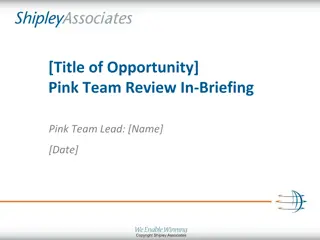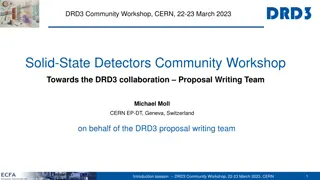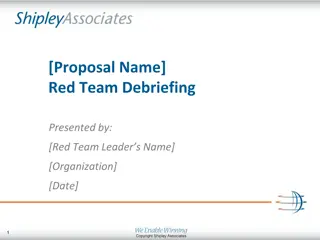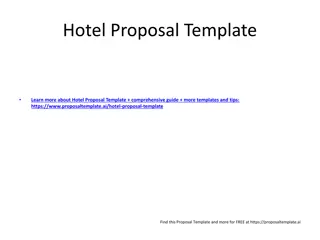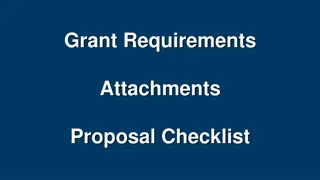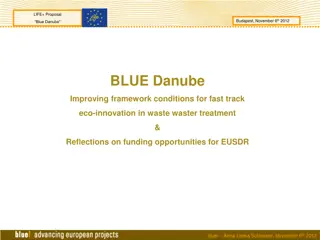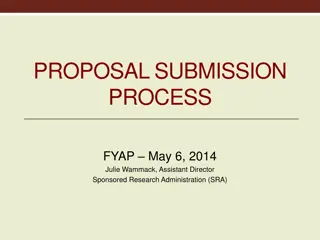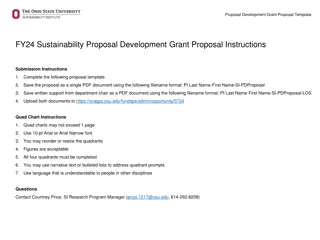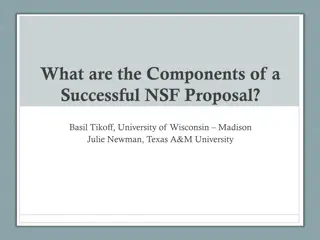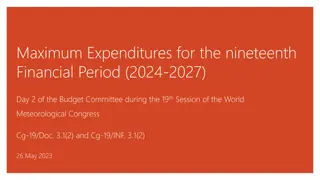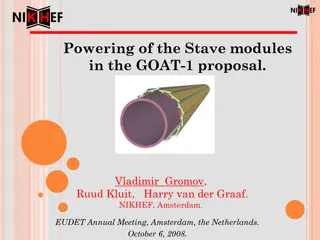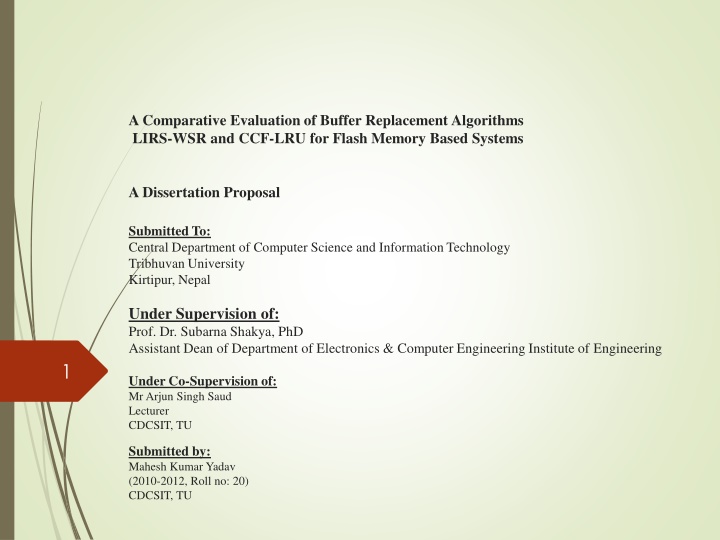
Buffer Replacement Algorithms Evaluation for Flash Memory Systems
"Explore a comparative evaluation of buffer replacement algorithms LIRS-WSR and CCF-LRU for flash memory systems in this dissertation proposal. Understand the impact on performance and write costs, aiming to optimize flash-based storage efficiency."
Download Presentation

Please find below an Image/Link to download the presentation.
The content on the website is provided AS IS for your information and personal use only. It may not be sold, licensed, or shared on other websites without obtaining consent from the author. If you encounter any issues during the download, it is possible that the publisher has removed the file from their server.
You are allowed to download the files provided on this website for personal or commercial use, subject to the condition that they are used lawfully. All files are the property of their respective owners.
The content on the website is provided AS IS for your information and personal use only. It may not be sold, licensed, or shared on other websites without obtaining consent from the author.
E N D
Presentation Transcript
A Comparative Evaluation of Buffer Replacement Algorithms LIRS-WSR and CCF-LRU for Flash Memory Based Systems A Dissertation Proposal Submitted To: Central Department of Computer Science and Information Technology Tribhuvan University Kirtipur, Nepal Under Supervision of: Prof. Dr. Subarna Shakya, PhD Assistant Dean of Department of Electronics & Computer Engineering Institute of Engineering 1 Under Co-Supervision of: Mr Arjun Singh Saud Lecturer CDCSIT, TU Submitted by: Mahesh Kumar Yadav (2010-2012, Roll no: 20) CDCSIT, TU
Overview 2 Introduction Flash Memory LIRS-WSR CCF-LRU Problem Definition Objective Literature Review Traditional Buffer Replacement Buffer Replacement Algorithm for Flash Based Systems Research Methodology Program Development Performance Matrices Expected Results Tentative Schedule
Introduction 3 Flash Memory Flash memory is non-volatile, shock resistant, and power economic. Flash memory is now among the top choices for storage media in embedded systems [1]. The I/O cost of read and write operations is significantly asymmetric in flash memory. The write operation is about 10 times slower than the read operation, and the erase operation is about 20 times slower than the write operation [3, 4, 5]. To improve the performance of flash based systems, we should reduce the frequency of write operation.
Introduction 4 Flash Memory The traditional magnetic-disk-based buffering algorithms LRU [6], LIRS [5], ARC [7, 8] etc. focus on hit-ratio improvement alone, but not on write costs caused by the replacement process. Algorithms LIRS-WSR [3] and CCF-LRU [11] were proposed as new buffering algorithms for flash-based systems. These new flash based buffer replacement policies consider not only buffer hit ratios but also replacement costs incurring when a dirty page has to be propagated to flash memory. These algorithms favour to first evict clean pages from the buffer so that the number of writes incurring for replacements can be reduced.
LIRS- WSR Algorithm 5 LIRS-WSR (Low Inter-reference Recency Set Write Sequence Reordering) algorithm [3] is modification of LIRS algorithm with the application of WSR technique. The objective of LIRS-WSR is to reduce the number of flushes of dirty pages from the buffer into flash memory when page replacement occurs. The concepts IRR, Recency, LIR pages, HIR pages, Stack pruning, LIRS stack and HIR queue are same as in original LIRS algorithm. Additional information cold or not-cold status of each page is recorded.
LIRS- WSR 6 When an LIR page is moved from Stack bottom to head of HIR queue, WSR policy is applied. WSR policy is a second chance policy in which, The page is checked to find whether it is cold or not. If it is found not-cold and dirty, then its cold flag is set and moved to top of LIRS stack, next page is checked. Otherwise The page is moved to the head of HIR queue, switching its status to HIR resident page. This delays eviction of dirty not-cold pages from buffer to flash memory. This reduces the number of write operations performed during page replacement.
CCF-LRU Algorithm 7 CCFLRU [11] (Cold-Clean-First LRU) algorithm is buffer replacement algorithm for flash-based systems which focuses to improve the overall I/O performance by focusing on reducing the write count incurring in the replacement process.. The CCF-LRU algorithm maintains two LRU lists, which are called mixed LRU list and cold clean LRU list. The mixed LRU list contains L1 pages and is used to maintain hot clean pages and dirty pages regardless of the status of its cold flag and the cold clean LRU list with the size of L2 is only for cold clean pages The first referenced pages are regarded as cold by default, each of which is inserted into the cold clean LRU list with a cold flag. When the page in the cold clean LRU list is referenced again or becomes dirty, it will be moved from the cold clean LRU list to the MRU position in the mixed LRU list.
CCF-LRU 8 When the page in the mixed LRU list is referenced, it will be moved to the MRU position of the mixed LRU list. The CCF-LRU selects a victim page by the following rules in order: If the cold clean LRU list is not empty, the LRU page in the cold clean 1. LRU list is selected as the victim; and 2. If the cold clean LRU list is empty, the LRU page in the mixed LRU list is chosen as the victim candidate. If the candidate is a cold dirty page, it is selected as the victim. If the candidate is a hot dirty page, it is labelled as cold and moved to the MRU position of the mixed LRU list. If the candidate is a hot clean page, it is set to cold and moved from the mixed LRU list to the MRU position of the cold clean LRU list, and we continue to check the LRU position in the mixed LRU list. If there is no victim found after traversing the mixed LRU list, it needs to call the CCF-LRU algorithm one more time to select a victim.
Problem Definition 9 The replacement algorithm with flash memory should consider not only the hit rate but also the replacement cost caused by selecting dirty victim pages. The evaluation of the buffer replacement algorithms for flash-based systems in terms of hit rate and write counts is required to compare their performance. Comparison among several buffer replacement algorithms have been found in different research papers, but comparison between LIRS-WSR and CCF-LRU has not been done yet. This dissertation work will mainly focus on comparative evaluation of these two algorithms: LIRS-WSR and CCF-LRU.
Objective 10 The main objective of this dissertation work is: To perform a comparative study of LIRS-WSR and CCF-LRU buffer replacement algorithms for flash based systems in terms of hit rate and write count; and To evaluate the performance of LIRS-WSR and CCF-LRU.
Literature Review 11 Traditional Buffer Replacement Algorithms Buffer Replacement algorithm identifies the victim page and replaces it by fetched page because of lack of primary storage. Many algorithms have been proposed so far. Among them, some well-known one s are: LRU [6]: evicts the page that has been used for longest period of time. CLOCK [13]: Considered as circular buffer. LIRS [5] : Based on two matrices: IRR and Recency. IRR: no. of distinct blocks access between last two consecutive accesses of data block Recency: no of distinct block access between last reference to current time. Clock Pro [15]: Similar principle as LIRS. ARC [7, 8]: Improves basic of LRU, splits into 2 parts. (T1 for recently and T2 for frequently referenced entries. MRU: Evicts recently used page.
Buffer Replacement Algorithms for Flash-Based Systems 12 Clean First LRU (CFLRU) [19] (Working region and Widow) Clean First Dirty Clustered (CFDC) (Working region and priority region) LRU - Write Sequence Reordering( LRU-WSR ) Cold Clean First LRU ( CCF-LRU ) [11] Low Inter-reference Recency Set WSR ( LIRS-WSR ) [3]
Research Methodology 13 This dissertation work is based on the trace driven simulation approach. All the data collected are primary data, which are real memory traces with different access pattern. For quantitative evaluation of the algorithms, the simulator program will be developed. The development of simulator program will be done in Java programming language. Collected input traces with different access pattern will be given as input to simulated algorithms. The output traces generated by the algorithms will be analyzed to calculate different performance metrics such page faults, hit rates, miss rates and write counts. Finally, the analyzed results will shown by different tables and graphs to draw conclusions.
Program Development 14 The algorithms will be implemented in Java programming language using ItelliJ IDEA on Intel( R) Core (TM) i5-4210U CPU @ 1.7 GHz-2.3GHz with 4 GB RAM Windows 10 64 bit OS. The data structure to simulate buffer will be doubly linked list . Each node of the list will contain appropriate data and pointer fields.
Performance Metrics 15 The performance of buffer replacement algorithm is measured in terms of page fault count, hit rate , miss rate and write count. Higher hit rate of the algorithm exhibits higher performance. In case of flash based system, less number of write count is measure for better performance.
Expected Result 16 As CCF-LRU tries to integrate the properties of frequency and cleanness into the buffer replacement policy whereas LIRS-WSR considers the recency and cleanliness of page references, it is expected that CCFLRU will outperform LIRS-WSR in terms of both hit rate and write counts.
Tentative Schedule 17 Activities 1w 1w 1w 1w 1w 1w 1w 1w 1w 1w 1w 1w 1w 7w Paper Study and Analysis 3w Proposal Preparation 3w Implementation Testing and Data Collection 3w 6w Documentation 1w Review * Presentation
References 18 [1] L.-P. Chang and T.-W. Kuo, Efficient management for large-scale flash-memory storage systems with resource conservation, ACM Transactions on Storage (TOS), vol. 1, no. 4, pp. 381 418, 2005. [2] N. Toshiba, vs. nor flash memory technology overview, tech. rep., Technical Report, 2006. [3] H. Jung, K. Yoon, H. Shim, S. Park, S. Kang, and J. Cha, Lirs-wsr: Integration of lirs and writes sequence reordering for flash memory, in International Conference on Computational Science and Its Applications, pp. 224 237, Springer, 2007. [4] H.-j. Kim and S.-g. Lee, A new flash memory management for flash storage system, in Computer Software and Applications Conference, 1999. COMPSAC 99. Proceedings. The Twenty-Third Annual International, pp. 284 289, IEEE, 1999. [5] E. Gal and S. Toledo, Mapping structures for flash memories: techniques and open problems, in IEEE International Conference on Software-Science, Technology & Engineering (SwSTE 05), pp. 83 92, IEEE, 2005. [6] A. Silberschatz, P. B. Galvin, G. Gagne, et al., Memory management strategies, Operating System Concept, 8th ed. Wiley Student Edition, pp. 315 417. [7] S. Jiang and X. Zhang, Lirs: an efficient low inter-reference recency set replacement policy to improve buffer cache performance, ACM SIGMETRICS Performance Evaluation Review, vol. 30, no. 1, pp. 31 42, 2002. [8] N. Megiddo and D. S. Modha, Arc: A self-tuning, low overhead replacement cache., in FAST, vol. 3, pp. 115 130, 2003. [9] S.-y. Park, D. Jung, J.-u. Kang, J.-s. Kim, and J. Lee, Cflru: a replacement algorithm for flash memory, in Proceedings of the 2006 international conference on Compilers, architecture and synthesis for embedded systems, pp. 234 241, ACM, 2006. [10] P. Jin, Y. Ou, T. H arder, and Z. Li, Ad-lru: An efficient buffer replacement algorithm for flash-based databases, Data & Knowledge Engineering, vol. 72, pp. 83 102, 2012.
19 [11] Z. Li, P. Jin, X. Su, K. Cui, and L. Yue, Ccf-lru: a new buffer replacement algorithm for flash memory, IEEE Transactions on Consumer Electronics, vol. 55, no. 3, pp. 1351 1359, 2009. [12] M.-L. Chiang, P. C. Lee, and R.-C. Chang, Managing flash memory in personal communication devices, in Consumer Electronics, 1997. ISCE 97., Proceedings of 1997 IEEE International Symposium on, pp. 177 182, IEEE, 1997. [13] F. Corbato, Festschrift: In honor of pm morse, chapter a paging experiment with the multics system, pages 217 228, 1969. [14] E. J. O neil, P. E. O neil, and G. Weikum, The lru-k page replacement algorithm for database disk buffering, ACM SIGMOD Record, vol. 22, no. 2, pp. 297 306, 1993. [15] S. Jiang, F. Chen, and X. Zhang, Clock-pro: An effective improvement of the clock replacement., in USENIX Annual Technical Conference, General Track, pp. 323 336, 2005. [16] D. Lee, J. Choi, J.-H. Kim, S. H. Noh, S. L. Min, Y. Cho, and C. S. Kim, Lrfu: A spectrum of policies that subsumes the least recently used and least frequently used policies, IEEE transactions on Computers, vol. 50, no. 12, pp. 1352 1361, 2001. [17] D. Shasha and T. Johnson, 2q: A low overhead high performance buffer management replacement algoritm, in Proceedings of the Twentieth International Conference on Very Large Databases, Santiago, Chile, pp. 439 450, 1994. [18] J. T. Robinson and M. V. Devarakonda, Data cache management using frequency-based replacement, vol. 18. ACM, 1990. [19] C. Park, J.-U. Kang, S.-Y. Park, and J.-S. Kim, Energy-aware demand paging on nand flash- based embedded storages, in Proceedings of the 2004 international symposium on Low power electronics and design, pp. 338 343, ACM, 2004. [20] H. Paajanen, Page replacement in operating system memory management, 2007.
20 Thank You!



